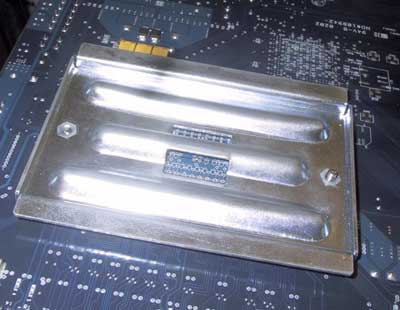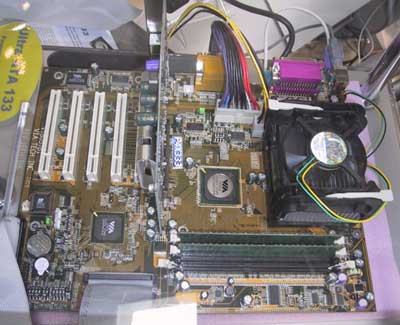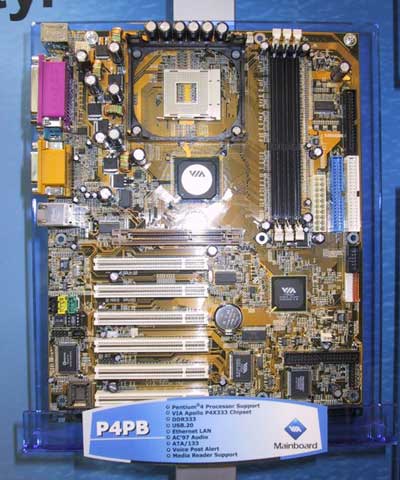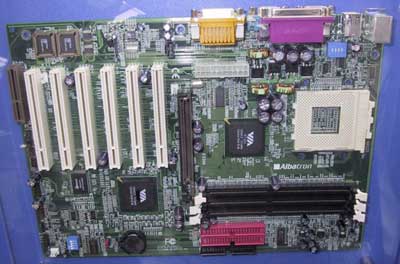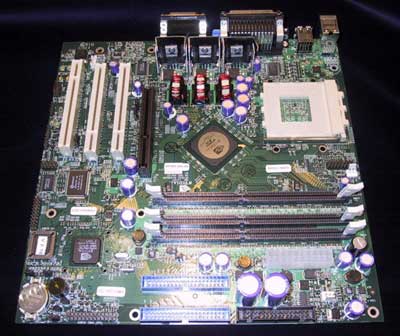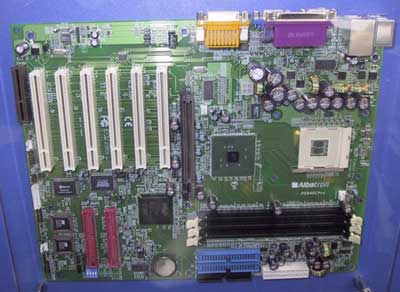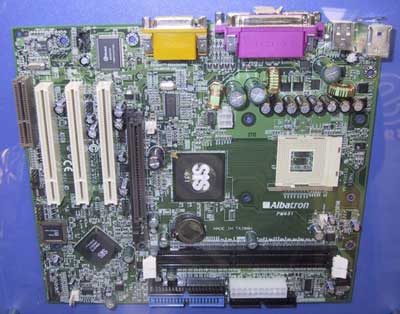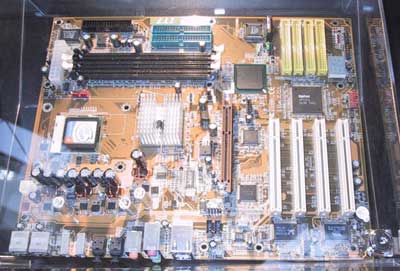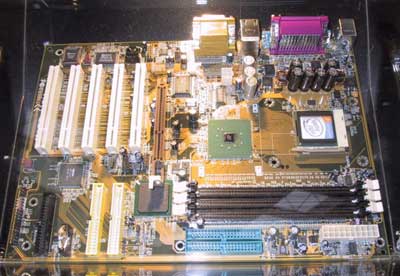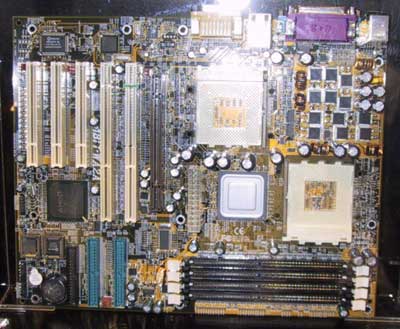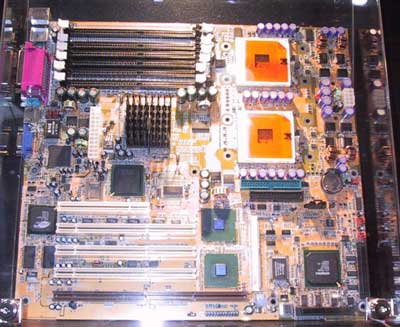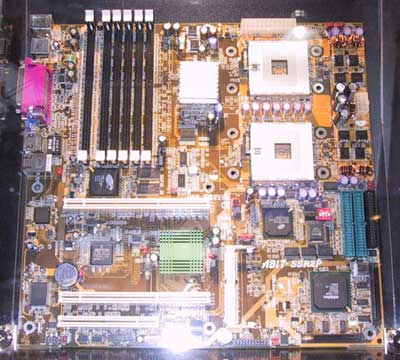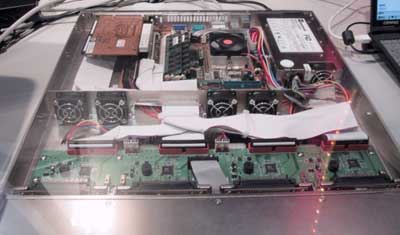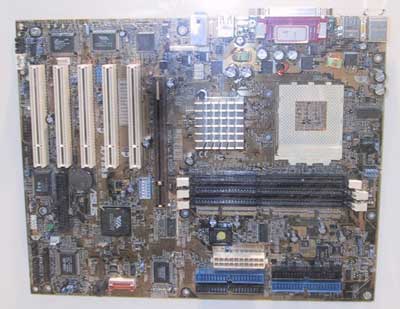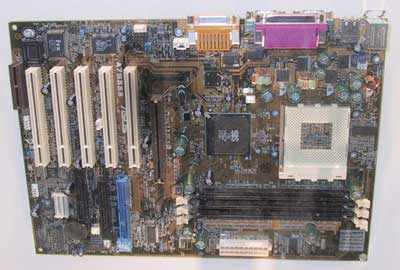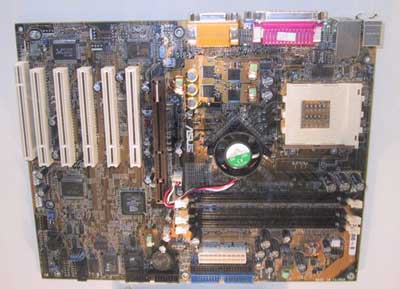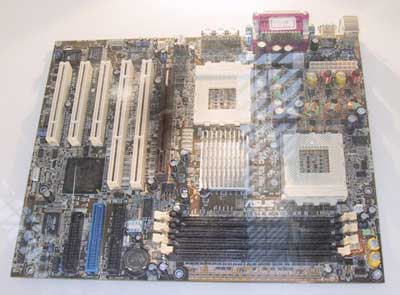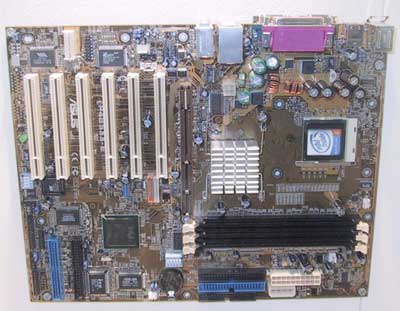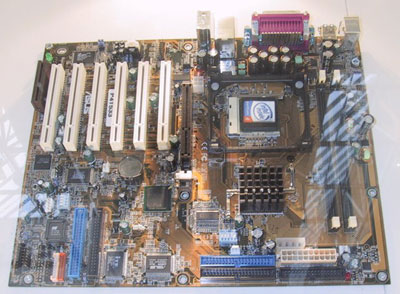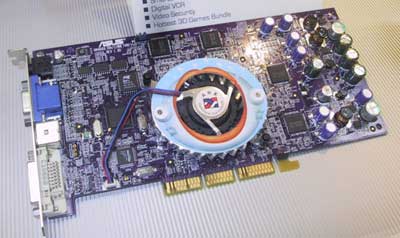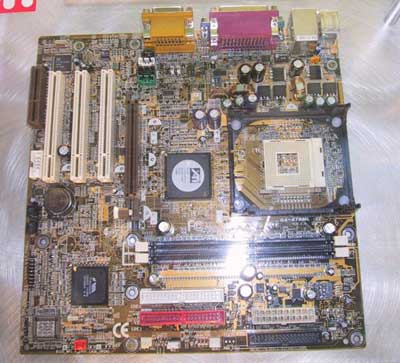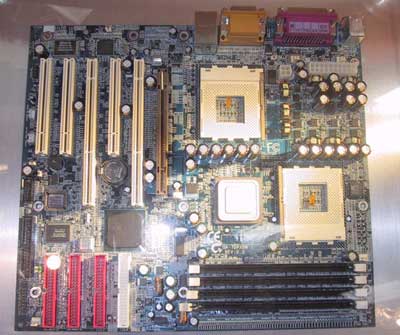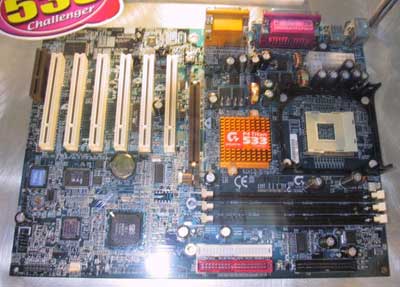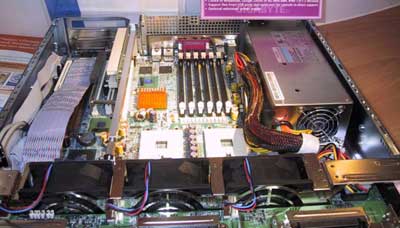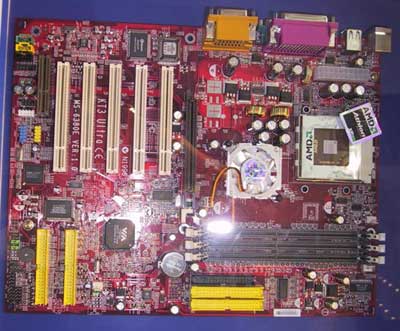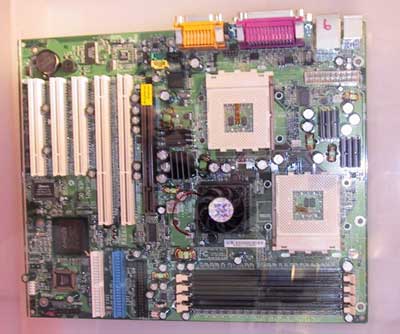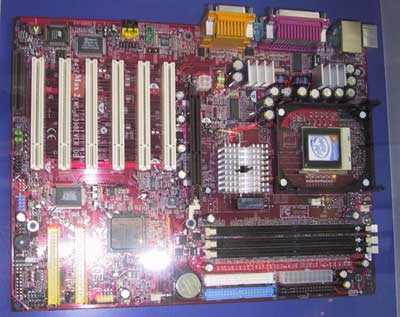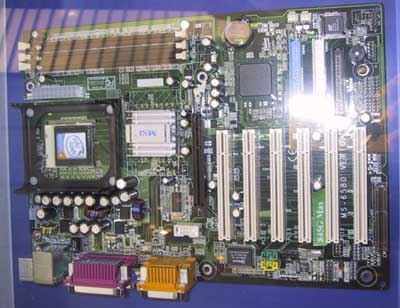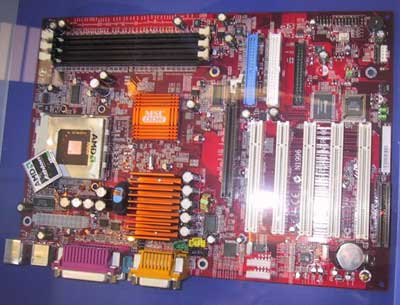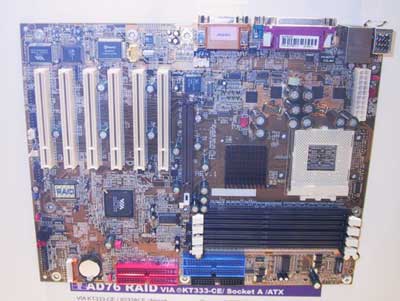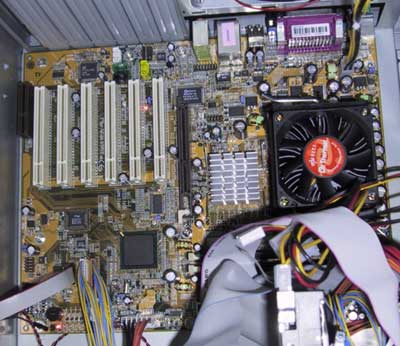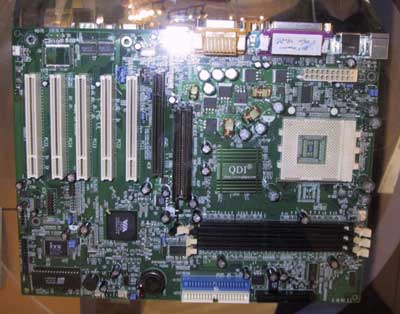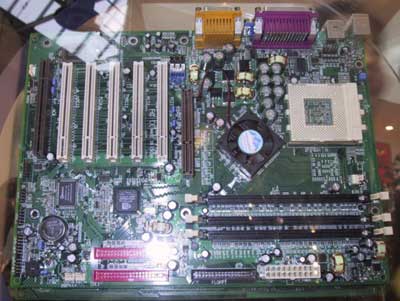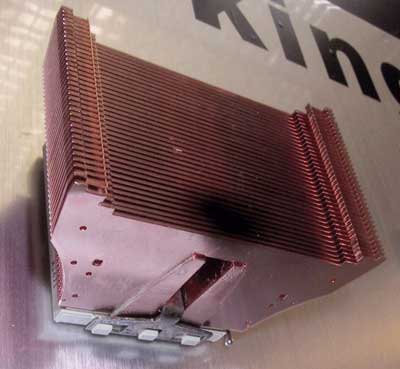
Original Link: https://www.anandtech.com/show/891
CeBIT 2002 Part 2 - CPUs, Cooling, Motherboards, & Video
by Tillmann Steinbrecher on March 20, 2002 1:56 AM EST- Posted in
- Trade Shows
Introduction
If you enjoyed part 1 of our CeBIT coverage you're definitely going to like this piece. We won't spend any time talking about the boring details so let's hop right into everything from more Hammer demos, to Intel's 845G, plastic heatsinks and more.
AMD
AMD presented their Athlon XP 2100+ (running at 1733MHz) and Athlon
MP 2000+ (1600MHz) at CeBIT. These CPUs are the final incarnation of the Palomino
core. They also introduced the Mobile Athlon 1600+, running at 1.4GHz.
Just like at IDF, the "really exciting stuff", the Hammer, was only displayed
behind closed doors, and not shown to the public. The Hammer demo was identical
to the one at IDF, of
which Anand has already reported: Two machines, one running 64-bit Linux
with the "bouncing
balls" demo, and one running Windows XP. In addition to bouncing balls,
the Linux machine was also running a web server - nevertheless, the system wasn't
very busy; the 'top' command revealed that the CPU was running 99% idle. Once
again, the clock speed at which the Hammer was running was not revealed.
The AMD "Solo" board was the same that was already displayed at IDF, with one
minor exception: the "Intel Jingle" taunt was removed. At IDF, the board had
the melody of the Intel jingle silkscreened on it. as you can see on the first
image. On the CeBIT demo board (second image) this was scratched off and covered
by stickers - because "the lawyers didn't find it that funny" (we did, though).
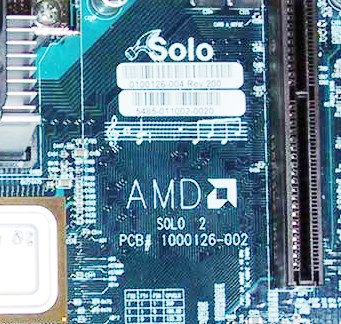
This was the Solo board from IDF, notice the musical notes
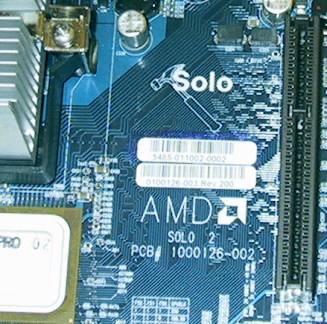
But at CeBIT, AMD's legal department rained on their parade - the notes are
gone.
We also got a shot of the backside of the board, to show the heatsink
mounting. The heatsink is not fixed to the board itself, but to strong metal
plate. This solves the problem of motherboards bending due to the mounting pressure
of the heatsink, which is indeed an issue with P4 boards.
At this CeBIT, we could finally see a wide choice of dual Athlon motherboards, thanks to the availability of the AMD 760MPX chipset.
Intel
Intel presented the Xeon MP (for multiprocessor) on CeBIT. In
contrast to the normal Xeon, which only supports dual CPU configurations, the
Xeon MP allows more than two CPUs to coexist in a system. The maximum clock
speed of the Xeon MP is currently 1.6GHz - since it is still based on the old
"Foster" core, and produced in 0.18µm circuit size. It features an additional
on-die 512KB or 1MB L3 cache.
More relevant for end users is that many motherboard manufacturers presented
motherboards based on the Intel 845 chipset at CeBIT. The 845 is Intel's latest
Pentium 4 chipset ith DDR SDRAM support. Especially interesting is the version
with integrated onboard graphics, the 845G. This is Intel's chipset with the
highest performance 3D features so far - it will be very interesting to see
how this chip set performs compared to ATIs and NVIDIAs new chipsets with onboard
graphics, once the first boards make it to the desks of the reviewers in a couple
of months.
VIA
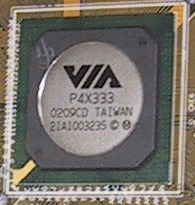 VIA had a few exciting things to show at CeBIT. They presented
a notebook version of their C3 chip, which has an average power usage of only
6 watts. It runs at 1.35 volts; like Intel's Mobile P3 processors it comes in
a micro FCPGA package. The maximum clock speed is 933MHz; the CPU is equiped
with 128K L1 and 64K L2 cache. The C3's performance isn't that great, but for
notebook users long battery life often matters more than high performance.
VIA had a few exciting things to show at CeBIT. They presented
a notebook version of their C3 chip, which has an average power usage of only
6 watts. It runs at 1.35 volts; like Intel's Mobile P3 processors it comes in
a micro FCPGA package. The maximum clock speed is 933MHz; the CPU is equiped
with 128K L1 and 64K L2 cache. The C3's performance isn't that great, but for
notebook users long battery life often matters more than high performance.
They also presented their new Pentium 4 chipset, the P4X333. Its new north bridge VT8754
supports up to 32 GB (!) of DDR333-SDRAM (PC2700). The VT8235 south bridge features
six USB 2.0 ports, as well as Utra ATA/133 IDE.
A working prototype of a board using this chip was displayed to the public at
the VIA booth.
This board was displayed to the public, running a 3D demo. Apparently, the
P4X333 north bridge runs really cool - on the demo system, it ran stable sans
North Bridge heatsink.
Motherboard manufactureres are a little reluctant towards offering VIA-based
P4 boards. This is because they fear legal pressure from Intel, since VIA doesn't
own a license for the P4 bus protocol. VIA has found a solution to this problem:
They sell motherboards under the "VIA mainboard" brand from VIA's Platform Solutions
Devision (VPSD), without disclosing the real manufacturer. Here's a shot of
one of these "VIA boards", using the P4X333:
SiS
SiS presented a new line of graphics chips, designed to compete with NVIDIA's
GeForce4 MX solutions. The "330" series chips are manufactured on a 0.15µm
process, and are running chip/memory clock speed combinations of 183/175 (SiS
328), 200/200 (SiS 332), 250/250 (SiS 334), or 300/275 (SiS 336). According
to SiS, the chip should perform better than a GeForce 4 MX running at the same
clock speed. Graphics cards will be equiped with 64 or 128MB RAM, and will support
AGP 8x.
SiS's Pentium 4 chipset SiS655 was also first to be seen at CeBIT. It features
two DDR SDRAM memory channels, and supports Intel's future P4 processors with
a 133MHz FSB clock (FSB533).
ATI and NVIDIA
ATI entered the chipset market with two chipsets with integrated graphics, for
P4 and Athlon - see our overview.
Judging from the amount of ATI based graphics cards, ATIs decision to start
selling their graphics chips to third party graphics card manufacturers was
a success. A large number of Taiwan-based motherboard / graphics card manufacturers
presented their ATI-based graphics cards.
NVIDIA presented a new version of their nForce chipset for AMD CPUs, which was
also already covered
in an AnandTech Industry Report.
Instead of handing out pencils or lighters, nVidia gave journalists samples
of the new GeForce4 Go (for notebooks) as a souvenir.
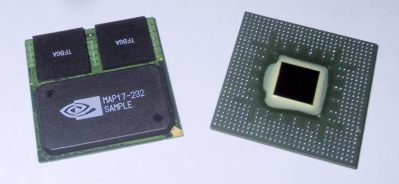
On the left side, the 32MB version. On the right side, the version with 64MB - here, the graphics core sits on the bottom side of the BGA packaging, and the upper side is occopied by four memory chips.
A new motherboard manufacturer: Albatron
Albatron's CEO worked for Gigabyte
before, and upon leaving he took several employees with him. So, even though
Albatron is new in the motherboard market, they have an experienced staff. Their
primary target is the market of system integrators. Albatron's boards are made
in Taiwan.
Interesting detail: Albatron's motherboards feature a dual BIOS called "TwinBIOS",
which obviously reminds us of Gigabyte's Dual BIOS feature - certainly not a
coincidence.
Albatron presented a very complete range of motherboards, with chipsets from
Intel, VIA, nVidia, SIS, as well as GeForce MX-based graphics cards.
This is Albatron's KT333 solution. Reading of the CPU temperature through the internal diode is currently under testing; it remains to be seen whether it will work in the final version. One inductor is a little close to the upper left edge of the CPU socket, which probably makes the motherboard incompatible with large heatsinks like the Alpha PAL8045.
This is Albatron's nForce motherboard - it was not displayed to the public, but shown only in the back room of the booth. This is not the final version; the shipping version will undergo a redesign as this is basically a clone of NVIDIA's reference board.
This is Albatron's Intel 845-based board with integrated graphics (845G). A version without onboard graphics is also available; it looks pretty much identical, so we're not posting another picture here.
Here's Albatron's P4 motherboard using the SIS 651 chipset.
ABIT
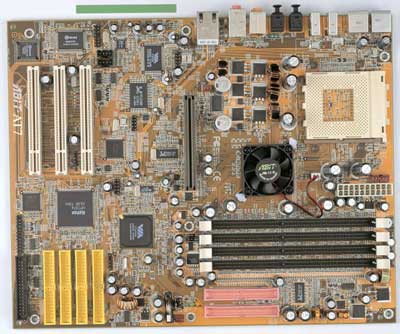
ABIT AT7 (picture from ABIT's "press kit" CD-ROM) - Click to Enlarge
This is ABIT's Via KT333 solution for Athlon. The board's layout
and features are quite unusual. The board only has 3 PCI slots, but the large
amount of onboard features compensates for that. This includes Highpoint onboard
IDE RAID, a Realtek Fast Ethernet chip, and an IEEE 1394 (FireWire) interface.
Also, note the four slots for DDR SDRAM. The on-board Highpoint RAID controller provides four Ultra ATA 133 RAID channels in addition to the two ATA 133 channels driven by the KT333 South Bridge. This allows for a total of 12 IDE drives to be attached to the motherboard.
Another interesting detail is the optical SP/DIF digital sound in- and output.
This is a great thing: Lots of copy-protected CDs that can't be ripped using
a CD-ROM drive are showing up on the market these days. With the aid of an audio
CD player with digital output (standard on most players) and an SP/DIF input,
it will still be possible to make perfect digital copies of such CDs - so we
are sure that there will be a lot of interest in motherboards and sound cards
with SP/DIF in. ABIT's idea to integrated these ports on all of its current
motherboards is certainly a step into the right direction.
The SP/DIF output is a nice idea as well - since it allows you to digitally
connect an external high end DAC or DAT/Minidisc recorder in order to do the
D/A conversion. In theory, this would give you much better sound quality than
any sound card can provide. However, most SP/DIF outputs are flawed, since they
only support 48kHz sampling rate. If sound is played at 44.1kHz (the sampling
rate of audio CDs and thus of most MP3s), the sampling rate will be converted
to 48kHz, which degrades quality. Only the sound chips from CMedia do not have
this problem and can do perfect SP/DIF out at 44.1kHz - but unfortunately ABIT
is using the chipset's AC97 audio, and not a CMedia chip.
The AT7 has a few more disadvantages. One is obvious: the lack of legacy serial/parallel
ports (which can be an advantage for some). The other one is the fact that the
AT7 cannot read the internal thermal diode of the Palomino core, and relies
on a not-so-precise NTC which measures temperature below the CPU instead. ABIT's
excuse for this was that "the chipset doesn't support it" - that is very astonishing,
especially considering that ASUS, MSI, and DFI all have KT333 boards that do
support reading the temperature from the Palomino's on-die thermister.
Still, the AT7 looks like a very interesting board, this certainly isn't the
last time you'll read about it on AnandTech.
ABIT plans to ship future board with the four mounting holes for large heatsinks
around the socket. These holes are no longer mandatory in the latest revision
of AMD's specs, and some manufacturers already ship boards without the mounting
holes.
Here's a close-up of the connectors of ABIT's new motherboards. Note the Fire Wire and SP/DIF interfaces, and also note the lack of "legacy" serial and parallel ports.
This is ABIT's Intel 845-based board for P4. It has all the great
features of the AT7 (RAID, Fire Wire, SP/DIF interface), plus a Port 80 diagnostic
display for easy troubleshooting. Also check out the nice passive heatsink on
the chipset - certainly a much better solution than a tiny sink with an unreliable
and often noisy fan on it.
Just like the AT7, this is a legacy-free board.
The BD7II-RAID is a more "classical" board: No Port 80 diagnostic, and only RAID onboard. Legacy ports (serial, parallel) are included.
The WA2A is ABIT's dual Athlon solution. It has an "AMD-style"
power supply connector, like the first dual Athlon board from Tyan. Unless ABIT
includes an adaptor, this limits the choice of power supplies considerably.
This board can read the CPU's internal diode for thermal monitoring.
The SI2P dual Xeon board from ABIT, with onboard SCSI from Adaptec.
Apparently, ABIT is serious about entering the server market - here's their third dual CPU board, the SSR2P for dual Xeon.
Continuing over from their announcements last year in Taiwan (@ Computex 2001)
ABIT demonstrated more of their NAS (Network Attached Storage) solutions. Their
NAS solutions are based on a P3 system that runs Linux 2.4. The hard drives
are controlled through Highpoint IDE controllers, which support RAID 0 and 1
(mirroring and striping). RAID5 functionality is done in software; since the
CPU is quite fast compared to the processors of other NAS solutions, this should
not be a problem.
ABIT is offering their NAS solution in two versions: One in a 1U 19" rackmount
case, and one in a portable minitower case, targeted at SOHO users.
A shot of the 19" version. On this version, the drives are hotswapable; ABIT demonstrated this by removing and replacing one of the HDDs while copying files around on the filesystem. The copying was not interrupted, and as soon as the HD was replaced, the reconstruction began. This can be observed using their proprietary Windows-based monitoring software.
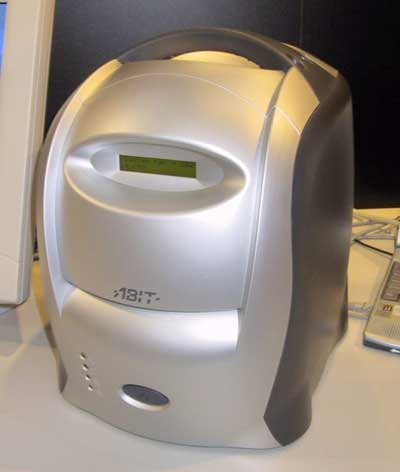
This is the SOHO version of the ABIT's NAS. It looks like the case design was done by hybridizing a Sony Aibo robot dog with an SGI O2 workstation.
ASUS
This is ASUS' KT333 motherboard. It can read the temperature from
the CPU's internal thermal diode, and halts the CPU in case of overheating.
On the ASUS stand, a video of what happens if you remove the heatsink during
operation was shown. This video was very similar to the video of AMD CPUs burning
up after heatsink removal that was posted on Tom's
Hardware Guide a while ago. But in this case, the CPU survived, and there
was no damage done. It remains to be seen whether independant testers will be
able to reproduce the positive result of this risky experiment - but if this
is the case, then it clearly shows that monitoring the CPU temperature through
the internal diode is far superior to the "measurement below CPU" method.
Another positive thing about this board is that ASUS finally got rid of the
unnecessary fan on the north bridge, and replaced it with a pretty large passive
heatsink.
The A7V333 comes with a 6-channel audio chip from CMedia. This chip has great
SP/DIF features; it is capable of doing perfect digital output at 44.1 and 48kHz.
However, ASUS did not include any optical SP/DIF connectors on the board, like
ABIT does, so this feature will probably remain unused in the most cases.
Just like ABIT, ASUS plans to ship future motherboards with the mounting holes
for heatsinks.
The A7S333 is based on the SIS 745 chipset. Unlike the A7V333, this board cannot read the internal thermal diode of the CPU. It also features 6-channel audio using a CMedia chip.
This is ASUS' nForce motherboard. The north bridge is cooled with
a tiny heatsink with a fan on it - other motherboard manufacturers ship their
nForce boards with a larger passive heatsink. We definitely prefer the passive
cooling solution, for reliability and noise issues. And even overclockers should
prefer a large passive heatsink - they can add a fan to it, and get much more
effective cooling than with this tiny heatsink and fan.
The board has onboard LAN using a Realtek chip. Apart from this, in has all
the typical features of an nForce board. The slot on the left that looks like
a reversed/skewed PCI slot hosts an add-on card that lets you take advantage
of the nForce's features, including SP/DIF out.
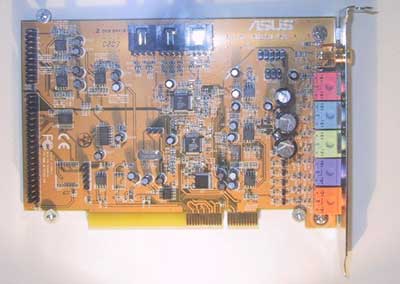
ASUS' dual Athlon motherboard:
Here's ASUS' 760MPX-based dual Athlon board. It comes with a four-pin "Pentium 4 style" power connector. Thermal monitoring through the internal CPU diode is supported.
This is the P4B533-E. Interesting detail: As with some previous ASUS P4 boards, this board does not require a power supply with ATX12V "P4 connector"; can get its additional power through a normal (hard drive/CD-ROM style) power supply connector. A different version called P4B-533 (without -E) with a slightly different layout and features is also available.
Here's the P4T 533. Again, an ATX12V from the power supply is not required.
This is ASUS' top-of-the line graphics card, based on the Geforce4 Ti 4600 running at 300MHz. It has 128MB DDR RAM (325 MHz), and features connectors for VGA, TV-ou, Video-In, DVD, and 3D glasses.
Gigabyte
Certainly the most interesting thing at Gigabyte's booth was this
motherboard with ATI's
Radeon IGP chipset. This board uses a VIA southbridge since ATI's
IXP (South Bridge) won't be ready until several weeks after the chipset
debuts.
Gigabyte also has plans for an nForce board, but does not offer one at the moment,
because their "relation with NVIDIA is not so good at the moment". This sounds
very credible - since Gigabyte were among the very first to switch to ATI chips
for their line of graphics cards.
Gigabyte's dual Athlon board. Unlike its competitors from ASUS,
ABIT and MSI, this board has an additional IDE controller from Promise and supports
up to eight IDE drives. But just like Gigabyte's other Athlon boards, it cannot
read the CPU's internal temperature sensor; thermal monitoring is done only
using NTCs in the CPU Socket. One of Gigabyte representatives suggested that
this was because of "patent issues" - we asked AMD about this, and the answer
was that there aren't any patent issues related to the CPU temperature monitoring.
The board gets its power through the ATX12V P4-style connector.
The P4 Titan 533 with SIS chipset, which already supports future P4 CPUs with 133MHz FSB.
Gigabyte's dual Xeon board, with six memory slots.
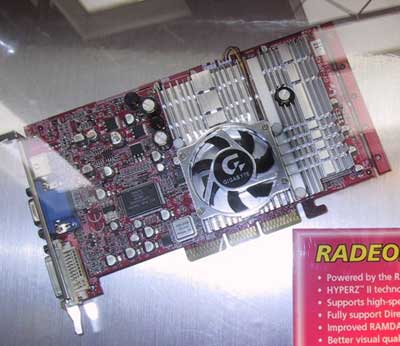
Gigabyte's High End graphics card, based on the ATI Radeon 8500. It features VGA, DVI, and TV output. Also, note the large heatsink which covers both GPU and RAM. It even has a hole to accommodate one of the capacitors - cute!
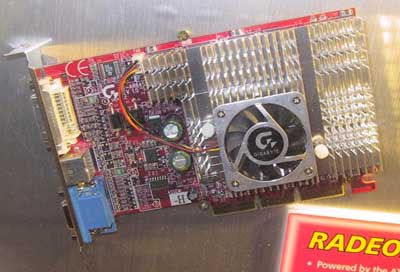
Another ATI-based graphics card from Gigabyte. It uses the less expensive Radeon 7500, but also has DVI and TV output.
MSI
MSI's KT333 motherboard is the KT3 Ultra. It can monitor CPU temperature through the CPU's internal sensor. It features a Promise IDE controller, and unfortunately also a small heatsink with fan on the north bridge, instead of a larger passive heatsink.
The MSI K7D-Master is MSI's AMD 760MPX-based dual Athlon board. CPU temperature is monitored through NTCs only, not using the CPU's own sensor. All current is supplied by the standard ATX power supply connector. On one hand, this is an advantage, since no power supply with special connector is required. On the other hand, it doesn't force users to have a newer power supply potentially raising some support issues for MSI. It'll be interesting to note how many support calls MSI gets about system instability or boards not posting with the culprit being the power supply.
Here's MSI's i845-based motherboard without onboard graphics.
MSI's 854G-based solution with onboard graphics
And here's a SIS chipset motherboard from MSI. Quite unusual are
the large heatsinks that cool all the transistors of the voltage regulation
circuit.
This raises a question: are large heatsinks on the voltage regulators a good
sign? The voltage regulation circuit on today's motherboards are nothing more
than a little switching power supply. If it is well-designed, its power dissipation
is very low, and little or no heatsinks are required (note that MSI's high end
board, the KT3 Ultra, as well as ASUS' or ABIT's boards have no heatsinks on
the voltage regulator's transistors). So, large heatsinks on a motherboard's
voltage regulators might also be a sign of a poor voltage regulation
circuit with a high power dissipation. But then, maybe MSI added the large heatsinks
just for additional safety - we certainly can't judge the quality of a motherboard's
voltage regulators just by looking at the size of the heatsinks.
Future MSI motherboards might no longer have the mounting holes for through-motherboard
heatsink mounting; in fact, on of the Athlon boards presented by MSI on CeBIT
already came without the holes.
DFI
DFI's AD76 RAID is a KT333-based board with a very complete configuration:
Six PCI slots, four DDR SDRAM sockets, onboard IDE RAID and LAN using a Realtek
Fast Ethernet chip. Also note the passive heatsink on the north bridge.
This motherboard should be capable of reading the CPU temperature from the on-die
sensor of the Palomino; additionally, it also features an NTC that allows temperature
monitoring of older Thunderbird CPUs without the on-die sensor. This is a very
good solution; however it remains to be seen whether the reading of the on-chip
thermal diode actually works, once the board makes it on the desk of the reviewers.
The most interesting thing at the DFI booth was not displayed to the public,
but shown only in a back room: A running 845G-based motherboard. Almost all
motherboard manufacturers showed 845G motherboards, but DFI were the only ones
to show a running board, so that the 3D features of the 845G could be judged.
The computer with this board was running side-by-side with a similarly equiped
PC with a GeForce4 MX 440. Both PCs were running Return to Castle Wolfenstein.
The game didn't run quite as smooth on the 845G's integrated graphics core as
on the GeForce, but it came very close - DFI stated that once the drivers
for the 845G were more mature, the performance could be identical. This
remains to be seen; but even in the current state we can say that the 845G's
integrated graphics core is far superior to previous to the graphics
cores on previous Intel chipsets.
Unfortunately, there's no Linux/Xfree86 support for the 845G's graphics core yet - but this might change in the future as well.
QDI Legend
The QDI KD7E is a plain vanilla KT333-based motherboard. There's no onboard RAID, LAN, or other special features. Thermal monitoring is done using a NTC below the CPU.
The N2 is QDI's nForce-based motherboard.
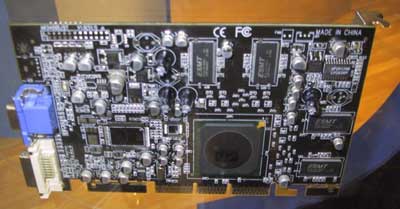
QDI is one among the many manufacturers that presented graphics cards based on ATI chips. Let's hope that the shipping version differs from the sample presented at CeBIT - at least as far as the mounting of the slot blade is concerned.
Cooling
Thermalright presented their SLK800 on CeBIT. This cooler is a larger version of their SK6, for usage with an 80mm fan. Considering how great the SK6 performed in our cooler tests, with just an 60mm fan, we have great expectations for the SLK800's performance. Thermalright also presented lots of other high-end models, and so did their competitors. By the end of each CeBIT day, we were loaded with heatsink samples - AnandTech's next cooler roundup will be exciting. A article dedicated to "CeBIT cooling news" will be published in the next days on The Heatsink Guide.
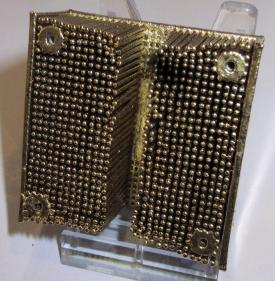
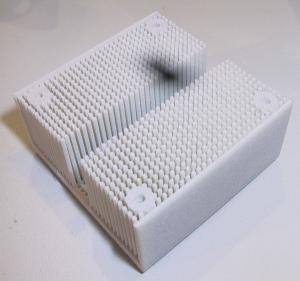
A heatsink made of plastic? Well, almost. Madex showed us first samples of an gold-plated carbon composite heatsink. Carbon has a great thermal conductivity, but only in one direction. Madex is experimenting with stacked carbon/copper heatsinks as well. Note that these coolers are still in the early stages of prototyping; they are produced using stereolithography. It will take a while until techniques for mass-producing such coolers at a reasonable price will be available.
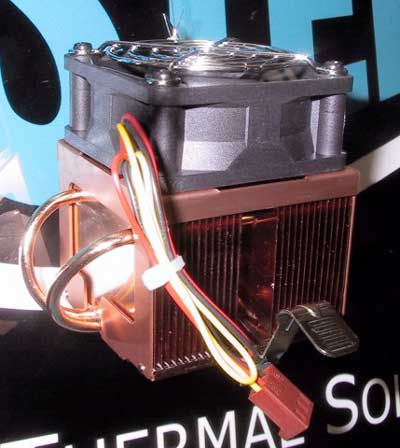
Cooler Master is offering a cooler with a heatpipe again. Note that these coolers only work well when mounted horizontally; for mounting in a tower case they are not so suitable.
Cases and Sound-Damping
Cooler Master presented a whole galaxy full of new aluminum cases:
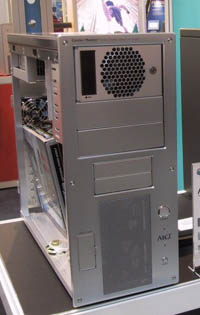 |
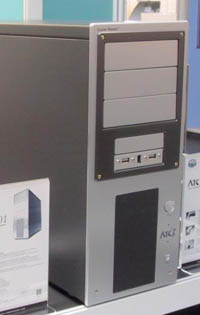 |
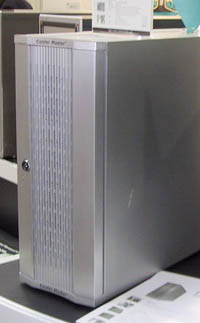 |
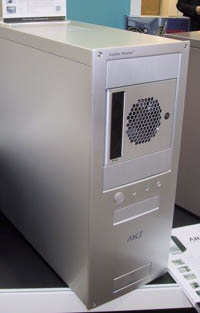 |
We've also seen several nice aluminum cases from other manufacturers - it's nice to have competition; let's hope that this will cause the prices of aluminum cases to drop.
Akasa, known to AnandTech readers mainly for their SilverMountain heatsinks, is now offering noise reduction mats, which you can use to make your PC quieter. This isn't exactly a new idea, but the fact that Akasa now sells them should lead to a wider availability of noise reduction mats - until now, only few retailers carry such things. The mats come with a self-glueing film on the backside for easy installation (you simply stick them inside your case).
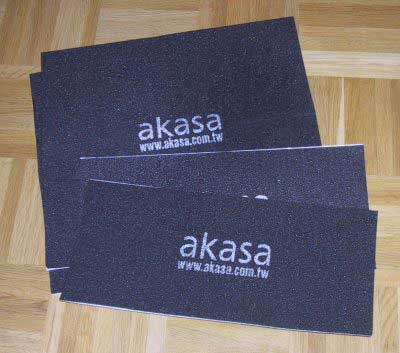
Final Words
As usual, we hope you enjoyed our coverage of the show. While we weren't able to provide daily updates from the show floor, these two parts should be able to give you a good overview of what's hot from this year's CeBIT.

